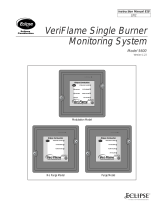
7BrightFire 200, V1, Operating Instructions, Edition 09.15
BrightFire® 200 Adjustable Burners
The BrightFire
®
200 is available in three body sizes, G, M
and B, with diameters of 73.0 mm (2.88”), 88.9 mm (3.50”)
and 101.6 mm (4.00”), respectively. All three sizes consist
of an outer tube with a separate inner tube to provide two
separate gas jets.
Each burner includes two adjustments (see Figure 2.1).
The first adjustment (the longer adjusting screw) changes
the annulus area between the inner and outer nozzle tips,
providing changes to the annular gas jet velocity at the
burner tip to control flame length. The second adjustment
(the shorter adjusting screw) is incorporated into the
middle tube and is used to open and close an orifice within
the annular gas jet which changes the gas flow
distribution between the inner and outer gas jets. This
unique inner flow adjustment allows the heat release from
the flame to be adjusted independent of the flame length.
See BrightFire
®
200 Flame Adjustment section for more
information.
Nozzles can be supplied with the burners for a variety of
inputs (2 to 10 MM Btu/h gross (528 to 2638 kW net) for
G-size; 5 to 17 MM Btu/h gross (1319 to 4484 kW net) for
M-size; and 10 to 31 MM Btu/h gross (2638 to 8177 kW
net) for B-size). Two types of nozzles are available to
provide flame length, heat release, and emissions tailored
to specific furnace requirements.
The two available nozzle types are a straight body nozzle
and a profiled nozzle. The profiled nozzle provides greater
heat and flame control when compared to the similarly
sized straight body nozzle. However, the same size
straight body nozzle will provide a reduction in NO
X
emissions compared to the profiled nozzle.
Oil lances are also available in a variety of inputs from 2
to 28 MM Btu/h (528 to 7388 kW). Oil lances are easy to
install in place of the inner gas tube for a flexible back-up
option in the event of natural gas interruptions.
The burner length and diameter must be determined from
the furnace and port information.
Gimbal Mounting Bracket Installation
NOTE: For additional info on the Gimbal Mounting
Bracket, refer to Info Guide 1113.
1. Set all bracket adjustments to zero using the scales and
pointers.
2. Place the socket plate in the recess of the burner block
3. Loosely attach bracket to furnace steel and roughly
align with the centerline of the burner block opening.
4. Install the alignment tube in the bracket, ensuring that
the alignment tube pin is in contact with the gimbal ring
of the bracket to simulate burner position and allow for
proper working distance from the socket plate to the
face of the burner nozzle.
5. With the alignment tube in place, push the bracket
assembly forward to hold the socket plate in place.
6. Sight down the alignment tube and adjust the bracket
to match the centerline of the tube to the centerline of
the burner block opening.
7. Tighten the mounting bolts of the bracket and secure
the socket plate to the block using the jack bolts on the
bracket. Slight adjustments may be required after heat-
up due to thermal expansion.
8. Tighten the bracket mounting bolts after final
adjustment and remove the alignment tube.
9. Seal the block opening with refractory fiber blanket for
heat up.
Pre-Start Considerations
• Ensure all components are on site: burners,
brackets, socket plates, etc.
• All threaded components should have anti-seize
applied.
• Ensure burner tool kit matches burner size. Kits
include: ratchet, spanner wrenches, burner
alignment tube, and anti-seize.
• Confirm cooling air has local flow control and
pressure gauge (0-15 PSI (0 – 1 bar)) for each
burner.
• Confirm gas has local flow control and measurement
provisions.
• Test the fit of the gas and cooling air flex hoses.
• Mount the burner and ensure supply lines can easily
be attached.
• Confirm cooling air and natural gas check valves are
fitted and within 2.5 m (8 ft) of the burner.
• Confirm that the check valves have been properly
installed in the gas and cooling air lines.
• Preset the manual gas flow control valve for each
burner to 50% open to allow for adjustment in both
directions and to establish a rough gas flow balance
across the burners.


















